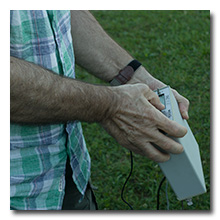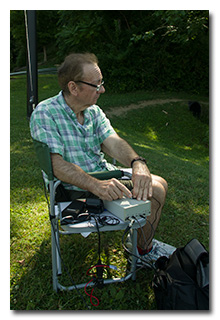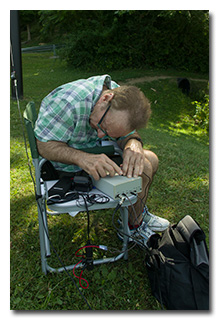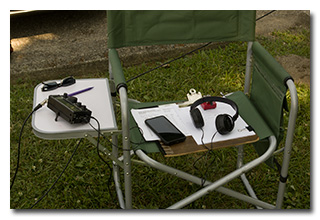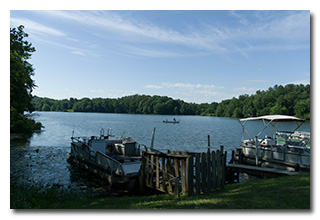
by William Eric McFadden
From the park's website:
-
Located within the rolling Appalachian foothills of southeastern Hocking Valley, Lake Logan State Park is secluded and offers a 400-acre lake for boating as well as prime hiking, fishing, and hunting opportunities.
Pictures
Description
On Friday, June 28, 2024, one member of the Southeast Ohio Radio Adventure Team performed a successful activation of Lake Logan State Park in Ohio as part of the Parks on the Air (POTA; link) program.
On his final day of use-or-lose vacation before the end of the fiscal year, Eric McFadden, WD8RIF, met Len Touth, W8VQ, at the fishing pier on Lake Logan State Park to perform an quick activation of the park and to help Len perform his second-ever POTA activation. Eric was accompanied by his little POTA-pup, Theo.
Eric and Len arrived individually at about 1330 UTC to find the fishing pier almost unoccupied. After parking their cars in the shady area of the lot, Eric walked Theo-dog, and then he and Len began deploying the station. Because the solar A-Index and K-Index were elevated and the N0NBH Solar Terrestrial Date page was showing "Poor" for all the HF bands, Eric wanted to deploy the best field antenna he could. Strapping Eric's 31' Jackite fiberglass telescoping mast to the fishing area's sign, he and Len deployed Eric's homebrew 40m end-fed halfwave (EFHW) antenna as an inverted-vee. Len was to operate first, and he chose to start using the vintage 40m TAC-1 transceiver he had built from a kit in the mid-1990s and had recently re-calibrated. (This was the very same transceiver he had used during the SEORAT's 1997 Freeze Your B___ Off event.)
As at Eric's previous activations of this park, Eric had good cell-signal and he would be able to spot Len and himself on POTA Spots (link) and to use POTA Spots to identify possible park-to-park (P2P) QSO opportunities.
Len made a number of QSOs without too much trouble on 40m, including a P2P QSO with Eric, with Eric using his Elecraft KH1, AXE1 40m extender, and whip for the QSO. When 40m dried up, Len swapped his TAC-1 for Eric's Elecraft KX2 and began running a frequency on 20m, easily reaching his required ten QSOs to validate his activation. As he had on 40m, Eric made a P2P QSO with Len, but this time he used his Elecraft KX3 driving a dummy load for the QSO.
After Len had validated his activation, Eric took over the KX2 and the 40m EFHW, found a clear frequency to run on 20m, and began calling "CQ POTA". His first QSO in this run came at 1512 UTC with W4JM in South Carolina. This was followed at 1514 UTC by a P2P QSO with W4MPT who was activating De Soto National Memorial (US-0772) in Florida. Unfortunately, within minutes of the start of Eric's operation, a lawn mowing crew arrived with three John Deere lawn tractors and a weed whacker, which made it challenging for Eric to copy CW, even with full-size over-the-ear headphones on.
Pausing to hunt P2P QSOs, at 1519 UTC Eric completed a P2P QSO on 20m with KQ6QB who was activating George J. Hatfield State Recreation Area (US-9355) in California, and at 1523 UTC he completed a P2P QSO on 20m with KI5GTR who was performing a two-fer activation of Sequoyah Bay State Park (US-2802) and McClellan-Kerr Wildlife Management Area (US-6359) in Oklahoma.
Returning to running his own frequency on 20m, at 1532 UTC Eric completed a QSO with WJ0L in Minnesota and in the following minute he completed a QSO with AD0IM in Kansas.
Pausing again to hunt for P2P QSOs, at 1539 UTC Eric made a P2P QSO on 20m with AB2II who was activating Haley Farm State Park (US-1675) in Connecticut.
Returning to his running frequency on 20m, Eric made one more QSO, at 1542 UTC, with KW4G in Florida.
Eric finished his activation by making one final P2P QSO with Len, this time on 30m, with Len using Eric's KX3 and dummy load.
In all, Eric made eleven QSOs, with eight P2P QSOs. All of Eric's QSOs were CW and were made with five watts output.
Over a nice lunch at Lake Logan Diner, Eric showed Len how to use Fast Log Entry (link) to create an ADIF and then how to upload the ADIF to POTA.
Eric also submitted his log to the World Wide Flora and Fauna in Amateur Radio (WWFF; link) program.
(return)
